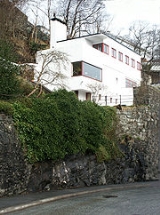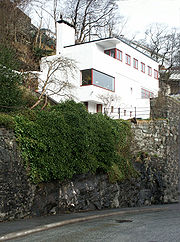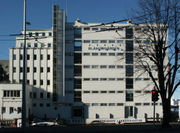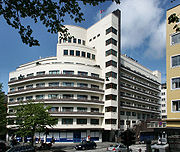
Leif Grung
Encyclopedia



Norway
Norway , officially the Kingdom of Norway, is a Nordic unitary constitutional monarchy whose territory comprises the western portion of the Scandinavian Peninsula, Jan Mayen, and the Arctic archipelago of Svalbard and Bouvet Island. Norway has a total area of and a population of about 4.9 million...
architect
Architect
An architect is a person trained in the planning, design and oversight of the construction of buildings. To practice architecture means to offer or render services in connection with the design and construction of a building, or group of buildings and the space within the site surrounding the...
. He was among the leading architects in Bergen during the 1920s and 1930's.
Background
Leif Grung was born in BergenBergen
Bergen is the second largest city in Norway with a population of as of , . Bergen is the administrative centre of Hordaland county. Greater Bergen or Bergen Metropolitan Area as defined by Statistics Norway, has a population of as of , ....
. He was from a family of Norwegian architects. His father was an architect, Georg H. Grung (1861–1932). His son was
Geir Grung
Geir Grung (architect)
Geir Grung was a Norwegian architect.He was born in Bergen as a son of architect Leif Kuhnle Grung, and took his education at the Norwegian National Academy of Craft and Art Industry in 1949. He studied together with Sverre Fehn, and cooperated with him on several occasions. From 1954 he ran an...
.
Leif Grung was educated in Stockholm
Stockholm
Stockholm is the capital and the largest city of Sweden and constitutes the most populated urban area in Scandinavia. Stockholm is the most populous city in Sweden, with a population of 851,155 in the municipality , 1.37 million in the urban area , and around 2.1 million in the metropolitan area...
where he studied architecture at the Institute of Technology and graduated in 1920. He established his own architectural studio in Bergen
Bergen
Bergen is the second largest city in Norway with a population of as of , . Bergen is the administrative centre of Hordaland county. Greater Bergen or Bergen Metropolitan Area as defined by Statistics Norway, has a population of as of , ....
during 1923. Grung went on to become one of the foremost pioneers for functionalism
Functionalism (architecture)
Functionalism, in architecture, is the principle that architects should design a building based on the purpose of that building. This statement is less self-evident than it first appears, and is a matter of confusion and controversy within the profession, particularly in regard to modern...
in Bergen.
Career
Leif Grung was a versatile architect marked by distinctive artistic nerve. He was open to international ideas and was inspired by both the BauhausBauhaus
', commonly known simply as Bauhaus, was a school in Germany that combined crafts and the fine arts, and was famous for the approach to design that it publicized and taught. It operated from 1919 to 1933. At that time the German term stood for "School of Building".The Bauhaus school was founded by...
school and by Frank Lloyd Wright
Frank Lloyd Wright
Frank Lloyd Wright was an American architect, interior designer, writer and educator, who designed more than 1,000 structures and completed 500 works. Wright believed in designing structures which were in harmony with humanity and its environment, a philosophy he called organic architecture...
. He also committed himself to the self-builder movement, to modernizing onshore communications and expanding the road system surrounding Bergen.
In the end of the 1920s, he became a standard-bearer for the functionalist movement in Bergen. As such, he often met heavy resistance, even from his colleagues. Nevertheless he was widely respected, enjoying high standing and popularity. Eventually he became the most productive architect in Bergen in the 1930s.
Grung designed both Kalmarhuset and Blaauwgården in Bergen. He also designed villas in the Tveiteås-area and Fjellveien/Starefossen-area. He also designed residential houses at Jægers minde, at Årstad and Langhaugen among others. Leif Grung designed a number of industry- and store houses during his career, but the may be most “functional” of all his designs was Statens kornsilo at Vaksdal Mølle.
After the end of the occupation of Norway by Nazi Germany
Occupation of Norway by Nazi Germany
The occupation of Norway by Nazi Germany started with the German invasion of Norway on April 9, 1940, and ended on May 8, 1945, after the capitulation of German forces in Europe. Throughout this period, Norway was continuously occupied by the Wehrmacht...
, he was accused of collaboration with the German occupation authorities and was expelled from the Bergen Architects Association. This led to his taking his own life. Just a few days after his suicide, the first prisoners of war from Germany returned home. These first witnesses confirmed that during World War II
World War II
World War II, or the Second World War , was a global conflict lasting from 1939 to 1945, involving most of the world's nations—including all of the great powers—eventually forming two opposing military alliances: the Allies and the Axis...
, Grung had been an intermediary for the escape route across the North Sea
North Sea
In the southwest, beyond the Straits of Dover, the North Sea becomes the English Channel connecting to the Atlantic Ocean. In the east, it connects to the Baltic Sea via the Skagerrak and Kattegat, narrow straits that separate Denmark from Norway and Sweden respectively...
to Great Britain
Great Britain
Great Britain or Britain is an island situated to the northwest of Continental Europe. It is the ninth largest island in the world, and the largest European island, as well as the largest of the British Isles...
and had sabotaged German building plans. In 1949, four years after his death, he was awarded the Houens fonds diplom for outstanding, independent and completed architectural works in commection with Blaauwgården.
Selected works in Bergen
- Mowinckel-gården, Olav Kyrres gate 9, (1924–25)
- Fridalens bungalow-bebyggelse, (1927–30)
- Statens kornsilo at Vaksdal Mølle, (1930)
- Jægers Minde, villaer, Hegreneset, (1930–37)
- villabebyggelse på Tveiteråsen, (1933–39)
- Blaauwgården, C. Sundts gate 1, (1936)
- Kalmarhuset, Jon Smørs gate 11, (1936)
- Bygård Fortunen ved Tårnplass, (1938).

